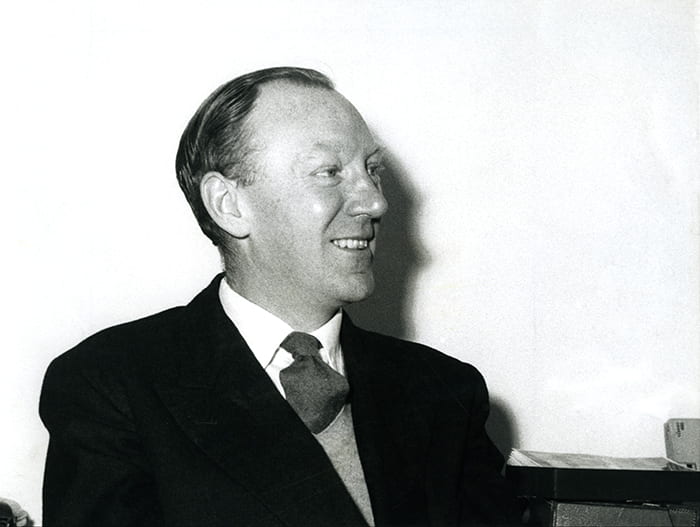
Ernest Race
Furniture and Textile Designer (1913-1964)
Soon after he was born in Newcastle on 16th October 1914 Race and his family moved to London. On leaving St Paul’s School in 1932 Race took a three-year course on interior design at the Bartlett School of Architecture. Although he quickly found employment as a model maker Race turned to lighting design and worked for Troughton and Young in 1936, under the lead of its in-house designer, A.B. Read RDI. However, his tenure was short lived as he decided to set up his own company, Race Fabrics, to sell handwoven textiles and carpets. His abstract designs were particularly appropriate for modernist architecture and were used extensively throughout Impington Village College, designed by Walter Gropius HonRDI and completed by Jack Howe RDI.
Race spent the Second World War as a member of the Auxiliary Fire Service. He had been a runner-up in an international competition for the design of storage units sponsored by the Museum of Modern Art, New York, that had attracted 3,000 entries from thirty different countries. This encouraged Race to respond to an advertisement, placed by engineer J.W. Noel Jordan, for a collaborator to design utilitarian, mass-produced furniture from unrestricted materials. The two men founded Ernest Race Ltd in 1945 with Race as Chief Designer and Jordan as Managing Director.
The BA3 dining chair, his first design for the company, became a showpiece at the 1946 Britain Can Make It exhibition. Over a quarter of a million of these cast aluminium chairs, combining lightness with elegance, were produced between 1945 and 1969 and Race was awarded a gold medal at the prestigious 1954 Milan Triennale exhibition for his design. He designed the ‘Springbok’ and ‘Antelope’ chairs for use as outside seating at the 1951 Festival of Britain and for the British pavilion at the 1958 World’s Fair, Brussels, Race designed his plywood and metal stacking ‘Unicorn’ chairs and tables.
Race’s metal furniture was enthusiastically received by both the private and contract sectors of the market. One of their first orders was for 1500 chairs and tables for troop ships that were bringing home demobilized servicemen. London furniture retailers Heals and Dunn’s both placed substantial orders as well as standardized furniture for Lyons teashops. In response to a design brief for an updated version of the Victorian steamer chair, from the P&O shipping company, Race produced an extremely simple and cost-effective response in his ‘Neptune’ lounge chair. The Design Centre awarded Race three ‘Design of the Year’ awards. The first was for his ‘Flamingo’ upholstered lounge chair in 1959. Race retired as director in 1954 but continued to work as a freelance designer for the company (which changed its name to Race Furniture Ltd in 1961). Jack Pritchard asked Race, in 1963, to update the design of the ‘Bottleship’ and the ‘Penguin Donkey’ for Isokon. His Mark II version of the donkey proved so popular that it has been in continuous production ever since, and a number of other early designs have been put back into production.
Appointed a Royal Designer for Industry (RDI) in 1953 Race took an active interest in the work of the Royal Society of Arts (RSA) Industrial Design Bursaries competitions, and served on the furniture section from 1954 until his death. Shortly after his election Race attended the lunch organized by the Faculty to mark the 80th birthday of Sir Ambrose Heal RDI and four years later he was one of the party at a dinner for Alvar Aalto HonRDI. Race was also a member of the Society of Industrial Artists and served as their President from 1958 to 1960. Three years later he was awarded their Design Medal.
Designers failed, in Race’s view, if they merely copied a design from one material to another, rather than exploiting the potential of the different material. Race played a key role in what came to be called the ‘contemporary’ style and he produce highly resolved and versatile designs from the most unlikely of materials. In the obituary he wrote for The Times, Robert Goodden RDI said that ‘to the young, in particular, he was a generous source of wisdom and experience’. Race served as a governor of the Technical College for Furnishing Trades at Shoreditch.
Ernest Race died at the relatively young age of 49 on 22nd January 1964.
Britain Can Make It Exhibition Catalogue 1946
- Group P: Furniture – items 110, 111
- Group RR: Furnished Rooms – item 555
Original image reference: GB-1837-DES-DCA-30-1-POR-R-1-1. Design Council Archive, University of Brighton Design Archives.

